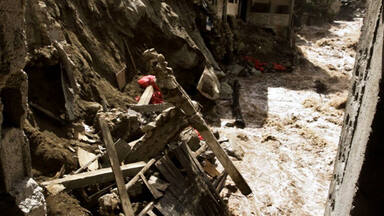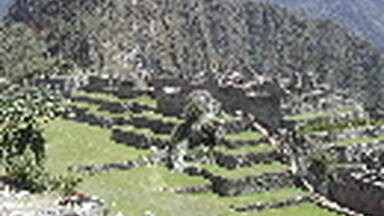Historic Sanctuary of Machu Picchu
Historic Sanctuary of Machu Picchu
Machu Picchu stands 2,430 m above sea-level, in the middle of a tropical mountain forest, in an extraordinarily beautiful setting. It was probably the most amazing urban creation of the Inca Empire at its height; its giant walls, terraces and ramps seem as if they have been cut naturally in the continuous rock escarpments. The natural setting, on the eastern slopes of the Andes, encompasses the upper Amazon basin with its rich diversity of flora and fauna.
Description is available under license CC-BY-SA IGO 3.0
Sanctuaire historique de Machu Picchu
À 2 430 m d'altitude, dans un site montagneux d'une extraordinaire beauté, au milieu d'une forêt tropicale, Machu Picchu a probablement été la création urbaine la plus stupéfiante de l'Empire inca à son apogée : murailles, terrasses et rampes gigantesques sculptent les escarpements rocheux dont elles paraissent le prolongement. Le cadre naturel, sur le versant oriental des Andes, fait partie du bassin supérieur de l'Amazone, riche d'une flore et d'une faune très variées.
Description is available under license CC-BY-SA IGO 3.0
معابد ماشو بيتشو التاريخيّة
على ارتفاع 2430 مترا، وفي موقعٍ جبلي في غاية الجمال، وسط غابة مدارية، من المرجح ان يكون ماشو بيتشو الابداع البشري الأبهى في أوجّ عظمة عهد الإنكا: أسوار مرتفعة وباحات ودرابزينات عملاقة تنحت الصخر لتبدو وكأنها امتداد طبيعي لها. ويشكّل الاطار الطبيعي على المنحنى الشرقي للأنديز، جزءًا لا يتجزّأ من حوض الأمازون الداخلي الغني بنباتات وحيوانات متنوعة.
source: UNESCO/CPE
Description is available under license CC-BY-SA IGO 3.0
马丘比丘古神庙
马丘比丘古庙位于一座非常美丽的高山上,海拔2430 米,为热带丛林所包围。该庙可能是印加帝国全盛时期最辉煌的城市建筑,那巨大的城墙、台阶、扶手都好像是在悬崖峭壁自然形成的一样。古庙矗立在安第斯山脉东边的斜坡上,环绕着亚马逊河上游的盆地,那里的动植物非常丰富。
source: UNESCO/CPE
Description is available under license CC-BY-SA IGO 3.0
Руины древнего города Мачу-Пикчу
Город находится на высоте 2430 м над уровнем моря в окружении тропических зарослей, в исключительно живописной горной местности. Мачу-Пикчу был, вероятно, самым удивительным городом государства инков, созданным в период его расцвета. Мощные стены, террасы и пандусы выглядят так, словно их создала сама природа, вырубив прямо в скалах. Этот район, располагающийся в верховьях Амазонки на восточных склонах Анд, отличается богатой флорой и фауной.
source: UNESCO/CPE
Description is available under license CC-BY-SA IGO 3.0
Santuario histórico de Machu Picchu
Ubicado a 2.430 metros de altura en un paraje de gran belleza, en medio de un bosque tropical de montaña, el santuario de Machu Picchu fue probablemente la realización arquitectónica más asombrosa del Imperio Inca en su apogeo. Sus murallas, terrazas y rampas gigantescas dan la impresión de haber sido esculpidas en las escarpaduras de la roca, como si formaran parte de ésta. El marco natural, situado en la vertiente oriental de los Andes, forma parte de la cuenca superior del Amazonas, que posee una flora y fauna muy variadas.
source: UNESCO/CPE
Description is available under license CC-BY-SA IGO 3.0
マチュ・ピチュの歴史保護区
source: NFUAJ
Historisch heiligdom Machu Picchu
Source: unesco.nl
Outstanding Universal Value
Brief Synthesis
Embedded within a dramatic landscape at the meeting point between the Peruvian Andes and the Amazon Basin, the Historic Sanctuary of Machu Picchu is among the greatest artistic, architectural and land use achievements anywhere and the most significant tangible legacy of the Inca civilization. Recognized for outstanding cultural and natural values, the mixed World Heritage property covers 32,592 hectares of mountain slopes, peaks and valleys surrounding its heart, the spectacular archaeological monument of “La Ciudadela” (the Citadel) at more than 2,400 meters above sea level. Built in the fifteenth century Machu Picchu was abandoned when the Inca Empire was conquered by the Spaniards in the sixteenth century. It was not until 1911 that the archaeological complex was made known to the outside world.
The approximately 200 structures making up this outstanding religious, ceremonial, astronomical and agricultural centre are set on a steep ridge, crisscrossed by stone terraces. Following a rigorous plan the city is divided into a lower and upper part, separating the farming from residential areas, with a large square between the two. To this day, many of Machu Picchu’s mysteries remain unresolved, including the exact role it may have played in the Incas’ sophisticated understanding of astronomy and domestication of wild plant species.
The massive yet refined architecture of Machu Picchu blends exceptionally well with the stunning natural environment, with which it is intricately linked. Numerous subsidiary centres, an extensive road and trail system, irrigation canals and agricultural terraces bear witness to longstanding, often on-going human use. The rugged topography making some areas difficult to access has resulted in a mosaic of used areas and diverse natural habitats. The Eastern slopes of the tropical Andes with its enormous gradient from high altitude “Puna” grasslands and Polylepis thickets to montane cloud forests all the way down towards the tropical lowland forests are known to harbour a rich biodiversity and high endemism of global significance. Despite its small size the property contributes to conserving a very rich habitat and species diversity with remarkable endemic and relict flora and fauna.
Criterion (i): The Inca City of the Historic Sanctuary of Machu Picchu is the articulating centre of its surroundings, a masterpiece of art, urbanism, architecture and engineering of the Inca Civilization. The working of the mountain, at the foot of the Huaya Picchu, is the exceptional result of integration with its environment, the result from a gigantic effort as if it were an extension of nature.
Criterion (iii):The Historic Sanctuary of Machu Picchu is a unique testimony of the Inca Civilization and shows a well-planned distribution of functions within space, territory control, and social, productive, religious and administrative organization.
Criterion (vii): The historic monuments and features in the Historic Sanctuary of Machu Picchu are embedded within a dramatic mountain landscape of exceptional scenic and geomorphological beauty thereby providing an outstanding example of a longstanding harmonious and aesthetically stunning relationship between human culture and nature.
Criterion (ix): Covering part of the transition between the High Andes and the Amazon Basin the Historic Sanctuary of Machu Picchu shelters a remarkably diverse array of microclimates, habitats and species of flora and fauna with a high degree of endemism. The property is part of a larger area unanimously considered of global significance for biodiversity conservation.
Integrity
The Historic Sanctuary of Machu Picchu meets the conditions of integrity, as the natural and human-made attributes and values that sustain its Outstanding Universal value are mostly contained within its boundaries. The visual ensemble linking the main archaeological site of the Historic Sanctuary of Machu Picchu with its striking mountain environment remains mostly intact.
It is desirable to extend the property to encompass an even broader spectrum of human-land relationships, additional cultural sites, such as Pisac and Ollantaytambo in the Sacred Valley, and a larger part of the Urubamba watershed would contribute to strengthening the overall integrity. In particular, the value for the conservation of the many rare and endemic species of flora and fauna would benefit from the inclusion or a stronger management consideration of the adjacent lands. A considerable number of well-documented threats render the property vulnerable to losing its future integrity and will require permanent management attention.
Authenticity
Upon the abandonment of the Historic Sanctuary of Machu Picchu at the beginning of the sixteenth century, vegetation growth and isolation ensured the conservation of the architectural attributes of the property. Although the design, materials and structures have suffered slight changes due to the decay of the fabric, the conditions of authenticity have not changed. The rediscovery in 1911, and subsequent archaeological excavations and conservation interventions have followed practices and international standards that have maintained the attributes of the property.
Protection and management requirements
The state-owned Historic Sanctuary of Machu Picchu is an integral part of Peru’s national protected areas system and enjoys protection through several layers of a comprehensive legal framework for both cultural and natural heritage. The boundaries of the Historic Sanctuary of Machu Picchu are clearly defined and the protected area is surrounded by a buffer zone exceeding the size of the property.
The Management Unit of the Historic Sanctuary of Machu Picchu (UGM) was established in 1999 to lead the strategies contained in the Master Plans, which are the regularly updated governing documents for the management of the property. UGM was reactivated in 2011 and is comprised of representatives of the Ministries of Culture, Environment and Foreign Trade and Tourism, the Regional Government of Cusco, serving as the President of the Executive Committee, and the local municipality of Machu Picchu. A platform bringing together key governmental representatives at all levels is indispensable for the management of a property which forms part of Peru’s very identity and is the country’s primary domestic and international tourist destination.
Notwithstanding the adequate legislative and formal management framework, there are important challenges to the inter-institutional governance and the effectiveness of management and protection of the property. The dispersed legislation would benefit from further harmonization and despite existing efforts the involvement of various ministries and governmental levels ranging from local to national remains a complex task, including in light of the sharing of the significant tourism revenues. Tourism itself represents a double-edged sword by providing economic benefits but also by resulting in major cultural and ecological impacts. The strongly increasing number of visitors to the Historic Sanctuary of Machu Picchu must be matched by an adequate management regulating access, diversifying the offer and efforts to fully understand and minimize impacts. A larger appropriate and increasing share of the significant tourism revenues could be re-invested in planning and management. The planning and organization of transportation and infrastructure construction, as well as the sanitary and safety conditions for both tourists and new residents attracted by tourism requires the creation of high quality and new long-term solutions, and is a significant ongoing concern.
Since the time of inscription consistent concerns have been expressed about ecosystem degradation through logging, firewood and commercial plant collection, poor waste management, poaching, agricultural encroachment in the absence of clear land tenure arrangements, introduced species and water pollution from both urban waste and agro-chemicals in the Urubamba River, in addition from pressures derived from broader development in the region. It is important to remember that the overall risks are aggravated by the location in a high altitude with extreme topography and weather conditions and thus susceptibility to natural disasters. Continuous efforts are needed to comply with protected areas and other legislation and plans and prevent further degradation. There is also great potential for restoring degraded areas.

 View photos from OUR PLACE the World Heritage collection
View photos from OUR PLACE the World Heritage collection

